| Pages:
1
2
3
4
5 |
j_sum1
Administrator
       
Posts: 6321
Registered: 4-10-2014
Location: At home
Member Is Offline
Mood: Most of the ducks are in a row
|
|
An AAS would be cool. Maybe Magpie could build one. 
In the meantime, I am happy with wet chemistry.
And for the surprise of the day... Gadolinite contains no gadolinium.
I will happily do some work on the rock around here. Up on Australia's Great Dividing Range -- which is old volcanic. It is all that classic aussie
red rock colour from the high iron content. (Soils in the area are classified as ferrosols.) It is quite ferromagnetic. I discovered this when I
dropped a magnet in the back yard and it came up covered in fine dust. Further investigation revealed that magnetic separation and concentration of
the iron compounds would not work. In the sample I worked with (which was devoid of organic material), all of the fine soil particles were
slightly attracted to a magnet.
I had a student last year attempt to isolate the iron with a thermite reaction but he had little success. It seems that there is quite a bit of Si
and Al in there that wouldn't budge. This all probably means that I am starting off with what might be one of the more difficult materials but we
will see how that goes. I have some finely divided soil from the last bit of excavation done around here. I can also chip off a piece of the ancient
lava flow that goes through the school. Results posted when I get them. I am however expecting problems with the digestion/leaching process.
|
|
|
Oscilllator
National Hazard
   
Posts: 659
Registered: 8-10-2012
Location: The aqueous layer
Member Is Offline
Mood: No Mood
|
|
Quote: Originally posted by j_sum1  | | I will happily do some work on the rock around here. Up on Australia's Great Dividing Range -- which is old volcanic. |
I live near the great dividing range (the blue mountains, to be precise) and it has always seemed to me that it was mostly sandstone. There is also a
band of coal that runs under pretty much the entire blue mountain area, and there are a bunch of coal mines on the western side. I even had the
opportunity once to do work experience in an underground one - one of the guys let me operate a continuous miner 
[Edited on 27-7-2015 by Oscilllator]
|
|
|
j_sum1
Administrator
       
Posts: 6321
Registered: 4-10-2014
Location: At home
Member Is Offline
Mood: Most of the ducks are in a row
|
|
Ok. I am in QLD.
As I understand it the GDR is a volcanic hot spot that cooled down as the crust drifted over it. There are a string of volcanoes up north (Glasshouse
mountains, Mt Warning etc) slowly becoming less dramatic as you progress south. I think it is a mistake to consider the range in terms of one kind of
geology. But I believe its linearity is not accidental.
Diddi will undoubtedly be along later to correct me or fill in some more details.
|
|
|
blogfast25
International Hazard
    
Posts: 10562
Registered: 3-2-2008
Location: Neverland
Member Is Offline
Mood: No Mood
|
|
XRF! 
|
|
|
Texium
Administrator
       
Posts: 4581
Registered: 11-1-2014
Location: Salt Lake City
Member Is Offline
Mood: PhD candidate!
|
|
The rocks around where I live are primarily very white, pure limestone with little streaks of iron oxide running through it, giving it a mottled white
and orange look.Occasionally there is some that looks more gray, but this seems to just be from a film of organic matter on the surface, as when
broken they still have the characteristic white and orange look. I dissolved some in HCl about a year and a half ago, and the white carbonate part
dissolved completely leaving behind most of the orange iron oxide. The solution was only slightly yellow, and boiling it down to dryness yielded
off-white crystals of partially hydrated calcium chloride that worked pretty well for deicing my sidewalk (not needed during most of the year, but it
was January).
|
|
|
aga
Forum Drunkard
    
Posts: 7030
Registered: 25-3-2014
Member Is Offline
|
|
Surely the iron oxide would react to form FeCl2 ?
|
|
|
blogfast25
International Hazard
    
Posts: 10562
Registered: 3-2-2008
Location: Neverland
Member Is Offline
Mood: No Mood
|
|
Red iron oxide is ferric oxide and dissolves to FeCl<sub>3</sub>. But very old ferric oxide can be remarkably inert (not responsive to
dilute acids).
|
|
|
aga
Forum Drunkard
    
Posts: 7030
Registered: 25-3-2014
Member Is Offline
|
|
Really ?!?!
What is it about the Age that prevents it reacting ?
|
|
|
blogfast25
International Hazard
    
Posts: 10562
Registered: 3-2-2008
Location: Neverland
Member Is Offline
Mood: No Mood
|
|
Test it yourself. Prepare some fresh Fe(OH)3, filter and wash. Then 'age' it. As it ages and becomes drier it dissolves in acids less and less easily.
That mineral stuff is millions (?) of years old.
|
|
|
aga
Forum Drunkard
    
Posts: 7030
Registered: 25-3-2014
Member Is Offline
|
|
Heat. I bet it gets all jiggy when woken up with some heat.
Edit:
One way to find out ...
Wouyld some old rust (maybe 9 years old) be a candidate for 'old ' ?
[Edited on 28-7-2015 by aga]
|
|
|
blogfast25
International Hazard
    
Posts: 10562
Registered: 3-2-2008
Location: Neverland
Member Is Offline
Mood: No Mood
|
|
Maybe, sometimes, also, too. I have some pottery grade Fe2O3 that doesn't dissolve in BOILING 98 % H2SO4. No dissolution
whatsoever<sup>*</sup>. It all depends on the overall thermal history of the oxide vis a vis how it will react with acids/bases.
* But it makes great thermite! 
[Edited on 28-7-2015 by blogfast25]
|
|
|
aga
Forum Drunkard
    
Posts: 7030
Registered: 25-3-2014
Member Is Offline
|
|
Thermoperv.
So what is the mechanism by which the iron oxide looses interest in acids ?
Surely this has been investigated, studied and is well understood.
Are we going Quantum Iron now (QI) ?
[Edited on 28-7-2015 by aga]
Panic ! This has a horrible Groundhog Day feel to it.
[Edited on 28-7-2015 by aga]
|
|
|
blogfast25
International Hazard
    
Posts: 10562
Registered: 3-2-2008
Location: Neverland
Member Is Offline
Mood: No Mood
|
|
Freshly precipitated Fe(OH)3 is really mostly water. That structure is very reactive to dilute acids.
As the product dries already it loses water and slowly converts to Fe2O3, already a lot less reactive to acids.
Calcining further removes water and tightens crystalline structure more, rendering it even less responsive to acids.
|
|
|
diddi
National Hazard
   
Posts: 723
Registered: 23-9-2014
Location: Victoria, Australia
Member Is Offline
Mood: Fluorescent
|
|
re the iron: zts was looking at iron in sand recently here http://www.sciencemadness.org/talk/viewthread.php?tid=62710#...
the point here is that iron is everywhere and secondly that HCl strips it out. Also he is left with SiO2 unreacted.
Beginning construction of periodic table display
|
|
|
blogfast25
International Hazard
    
Posts: 10562
Registered: 3-2-2008
Location: Neverland
Member Is Offline
Mood: No Mood
|
|
Quote: Originally posted by diddi  |
the point here is that iron is everywhere and secondly that HCl strips it out. Also he is left with SiO2 unreacted. |
It did in that case (sand) but I can assure you that HCl doesn't always 'strip' iron out of minerals, at least not without some prior treatment. I
suggest you try and dissolve a piece of mineral Hematite in HCl and report back to me on how well that went! 
Many iron bearing minerals don't respond to HCl at all. Don't oversimplify by extrapolating from zts's particular experiment.
[Edited on 29-7-2015 by blogfast25]
|
|
|
Texium
Administrator
       
Posts: 4581
Registered: 11-1-2014
Location: Salt Lake City
Member Is Offline
Mood: PhD candidate!
|
|
Yep, I was actually rather surprised at how well it sucked the iron out of that sand, given how the deposits in the limestone that I dissolved barely
reacted. I supoose it's due to a variety of factors including particle size, amount of time given to react, and the nature of the iron mineral. The
sand was soaked over the course of a day and a half, which was a lot more time than the limestone spent in the HCl, and it was of course present as
much smaller particles in the sand for the most part.
|
|
|
aga
Forum Drunkard
    
Posts: 7030
Registered: 25-3-2014
Member Is Offline
|
|
Quote: Originally posted by blogfast25  | | Calcining further removes water and tightens crystalline structure more, rendering it even less responsive to acids. |
Now there's an interesting thought, from an Energy perspective.
Fe2O3 in a crystal matrix 'tightening'.
Would it be that the matrix looses impurities, like water, and becomes more 'itself' thather than an impure version, or would it be that the bond
lengths decrease/become more geometrically and electronically stable ?
|
|
|
The Volatile Chemist
International Hazard
    
Posts: 1981
Registered: 22-3-2014
Location: 'Stil' in the lab...
Member Is Offline
Mood: Copious
|
|
"Friends don't let friends extrapolate" (Our school's stats teacher)
"But I love extrapolation..."
Stats is the voodoo of mathematics.
Anyways, I've got a sizable collection of those things earthy, and am going to southern Indiana this following week, which is where I like to go
rock-hunting. I've only ever attempted to digest a few rocks, but I enjoy the chemistry related to it. It would be interesting (for me, at least) to
chart up what color precipitates are made of different ratios of different ions when the ferricyanide and ferrocyanide indicators are used. I like
them solely because I own about 20g of both.
|
|
|
aga
Forum Drunkard
    
Posts: 7030
Registered: 25-3-2014
Member Is Offline
|
|
I like them cos the colours are pretty, tell you something about the composition, and always work as expected !
|
|
|
blogfast25
International Hazard
    
Posts: 10562
Registered: 3-2-2008
Location: Neverland
Member Is Offline
Mood: No Mood
|
|
Fluorite's two distinct colour variations:
https://www.google.co.uk/search?q=fluorite&rls=com.micro...
|
|
|
aga
Forum Drunkard
    
Posts: 7030
Registered: 25-3-2014
Member Is Offline
|
|
Beautiful !
Dissolve them in acid at once.
|
|
|
aga
Forum Drunkard
    
Posts: 7030
Registered: 25-3-2014
Member Is Offline
|
|
A bit of rock molesting
Samples A and C (see above) are basically the same, with A having a lot more silicate material, so sample A was discarded.
Added are samples D and E from the quarry (used to be a cement factory nearby) pictured above.
These are likely the same material too - they just looked different in situ.
3 portions of ~20g of each sample were put in 3 plastic 100ml pots (these are sold here for disposable party drinks very cheaply).
The sample pots were respectively treated with equal portions of approx 10% HCl Solution, ~48% H2SO4 solution and Distilled
water.
The intention was to leave the samples to react for 24 hours. As usual, Life got in the way and they have been left for several days.
Here is what they looked like after being left to react.
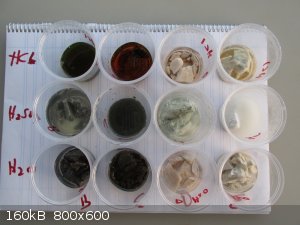
The Top row is samples B,C,D,E in HCl solution.
Middle is with sulphuric acid.
Bottom row is with water which shows the rock samples more-or-less as they were found.
The liquor (or lixiviate - love that word) from each HCl dissolved sample was tested for iron using Ammonium Thiocyanate solution.
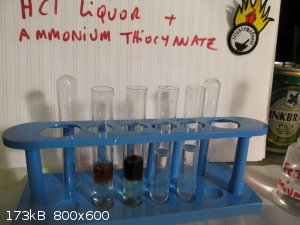
Suprisingly samples D and E showed NO iron cations !
Sample C is so heavy with iron that the test went 'blood red' as described in the textbooks.
Next the lixiviate of each H2SO4 sample was tested for Fe<sup>3+</sup> in the same way.
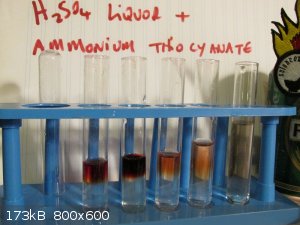
Suspicious of the positive results in samples D and E, a sample of the acid used was also tested as a control.
The photo may not show it well, but there is a very very faint red tinge to the control sample (right hand side test tube) indicating some traces of
iron.
Notwithstanding, samples D and E have more Fe<sup>3+</sup> as evidenced by the more pronounced colour.
The Water samples were tested, and none showed any sign of iron in this test.
Next a 6 [M] solution of NaOH was prepared by dissolving 12g of NaOH in 50ml of water.
For the following, each sample was taken with a clean plastic dropper-pipette, and 3 drops of each lixiviate was taken and added to a test tube.
The pipette was washed 3 times with 1.5ml clean DIW with the wash water added to the test tube, making approximately 5ml of dilute solution in the
test tube.
Drops of the 6 [M] NaOH solution were added until the solution showed as Basic with a universal pH test paper.
HCl lixiviate test results :
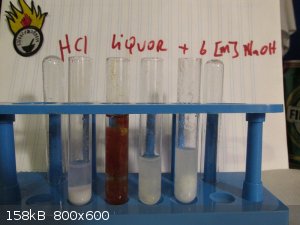
Sample B has a definite solid white powdery precipitate.
C has an indistinct Brown precipitate distributed throughout the liquid.
D and E (probably the same material) have a gelatinous white suspension.
The same test was performed on the Water samples, and no reaction was seen.
H2SO4 lixiviate with NaOH test results :
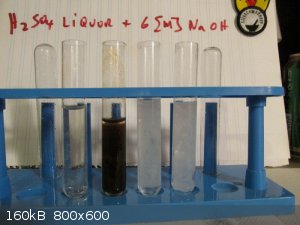
The results are similar to the HCl results, although sample B shows no reaction at all and Sample C has a very different character to the precipitate.
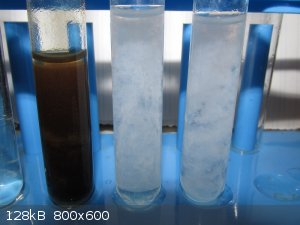
A surpring test was the pH of the resulting HCl solutions.
Samples D and E consumed ALL of the acid !
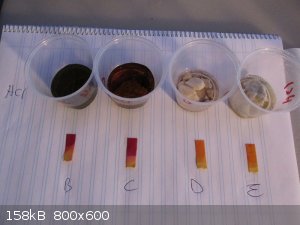
Not pictured are the tests with BaCl2 solution which showed no white precipitate with the HCl or Water portions, and as a control,
immediately showed a white precipitate with the H2SO4 solutions.
If i were a Proper Chemist, i would be able to work something out from all this.
|
|
|
blogfast25
International Hazard
    
Posts: 10562
Registered: 3-2-2008
Location: Neverland
Member Is Offline
Mood: No Mood
|
|
aga:
The slightly surprising results here are the white precipitates (after NaOH), almost certainly a metal hydroxide and likely to be Al(OH)3 (it
certainly looks like hydrated alumina).
If Al(OH)3 it will dissolve in an excess of NaOH but not in strong NH3. To test this properly filter, wash and collect filter cake. Then subject to 6
M NaOH and NH3 (aq).
During the acid treatments, did you see any CO<sub>2</sub> evolve?
[Edited on 29-7-2015 by blogfast25]
|
|
|
aga
Forum Drunkard
    
Posts: 7030
Registered: 25-3-2014
Member Is Offline
|
|
Gas was evolved in all samples, all acids.
Most vigorous with HCl, tested +ve for CO2.
I would go get the notes, but there's a snake in the shed again at the moment.
When they're happy and at ease they move slowly.
If Startled, they could easily smash up my glassware.
Usually they are gone in the morning.
|
|
|
blogfast25
International Hazard
    
Posts: 10562
Registered: 3-2-2008
Location: Neverland
Member Is Offline
Mood: No Mood
|
|
CO<sub>2</sub> means most likely CaCO3 and/or MgCO3. It also means your HCl lixiviates contain
Ca<sup>2+</sup> and/or Mg<sup>2+</sup>.
[Edited on 29-7-2015 by blogfast25]
|
|
|
| Pages:
1
2
3
4
5 |